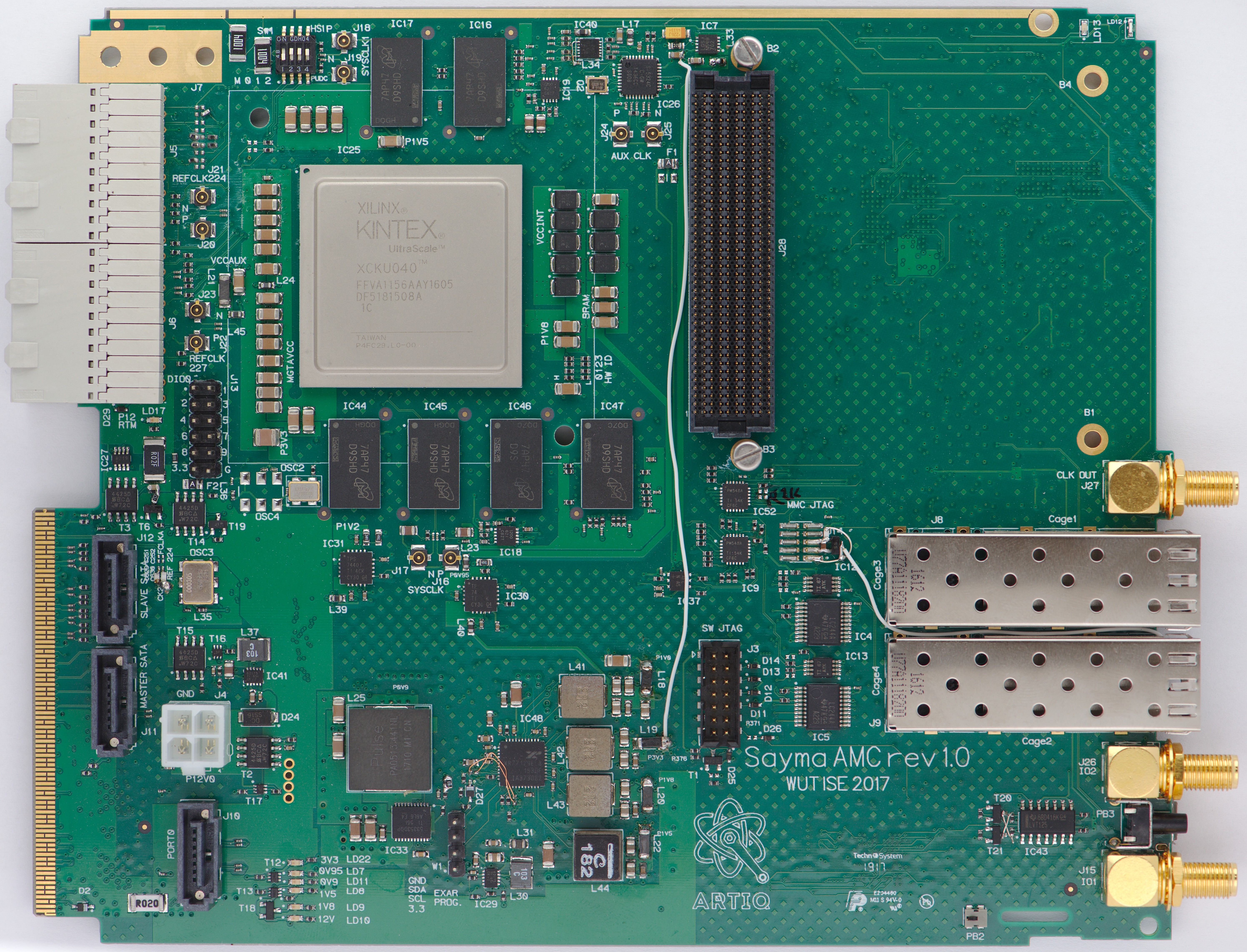-
Notifications
You must be signed in to change notification settings - Fork 6
Sayma
Sayma is a smart arbitrary waveform generator, providing 8 channels of 1.2 GSPS 16-bit DACs (2.4 GHz DAC clock) and 125 MSPS 16-bit ADCs. It consists of an AMC, providing the high-speed digital logic, and a RTM, holding the data converters and analog components.
| PCB | design files | schematics | manual |
|---|---|---|---|
| Sayma_AMC | ARTIQ_EE/PCB_Sayma_AMC | here | link |
| Sayma_RTM | ARTIQ_EE/PCB_Sayma_RTM | here | link |
The PCBs are double width, mid height AMC module.
The schematics and layout are made with Mentor Xpedition. There is a free viewer: visECAD Viewer. Note that for Sayma v2 Xpedition won’t be used .


- May be used in a uTCA rack or stand-alone operation with fibre-based DRTIO link
- Analog input and output front-ends provided by plug-in analog front-end modules (eg BaseMod) for maximum flexibility.
- Extremely flexible clocking options
- Flexible feedback to SAWG parameters planned. Specification here.
- FPGA: XCKU040-1FFVA1156C Kintex Ultrascale, 520 I/O, 530K Logic Cells, Speed Grade 1, 20 GTH transceivers (up to 16.3 Gb/s) -- motivation for this FPGA choice is here
- DRAM: MT41K256M16TW-107:P, DDR3, 32 MB x 16 x 8 banks = 4 GB
- clock recovery: Si5324 is a precision clock multiplier and jitter attenuator
-
DAC: AD9154 4-channel high-speed data converter
- data rate is 1.2 GS/s at 16-bit
- clock is up to 2.4 GHz (1x, 2x, 4x and 8x interpolating modes)
- supports mix-mode to emphasize power in 3rd Nyquist Zone
- interface is 8-lane JESD204B (subclass 1)
- power consumption is 2.11 W
- each Sayma has 2 AD9154
-
ADC: AD9656 is a 4-channel high-speed digitizer
- data rate is 125 MS/s at 16-bit
- clock is up to 125 MHz
- 650 MHz analog bandwidth
- interface is 8-lane, 8 Gb/s per lane, JESD204B (subclass 1)
- each Sayma has 2 AD9656
-
clock generation: (summarized here)
- Sayma has several distinct clock domains
- DAC, JESB204B output clock
- ADC, JESD204B input clock
- LO for analog mezzanines
- These clocks may be generated using a low phase noise Clock Mezzanine PCB. A single Clock Mezzanine can be shared by several Sayma in a uTCA crate using [Baikal] PCB and an RTM RF backplane. Alternately, each Sayma can have its own distinct Clock Mezzanine (local generation).
- Sayma has several distinct clock domains
-
clock distribution
- HMC7043 SPI 14-Output Fanout Buffer for JESD204B
- HMC830 SPI fractional-N PLL
- calibration ADC: AD7194BCPZ is a 20-bit ADC for monitoring/calibration
- SFP1: DRTIO downstream
- SFP2: DRTIO downstream
- SATA1: DRTIO upstream (different bitstream probably)
- SATA2 (swapped): DRTIO downstream
- FAT_PIPE1 (FABRICD): DRTIO upstream
- FAT_PIPE2 (FABRICE): not used
- FMC:
- LA: FMC DIO32: TTL IO
Front of board components: SMA USB/button SMA SFP SFP SMA FMC. Several LEDs lie under SFPs (left to right).
- LD3: user defined "SFP2"
- LD6: red if MMC is in error state (set by MMC)
- LD20: LINK_UP (set by MAX24287)
- LD18: MII1_MODE
- LD2: user defined "SFP2"
- LD5: user defined "SFP1"
- LD19: user defined
Mapping of SMA connectors to functionality for RTM.
O
O sawg7
O
O sawg6
O
O sawg5
O
O sawg4
O
O sawg3
O
O sawg2
O
O sawg1
O
O sawg0
O input for 100 MHz clock, 10 dBm
Sayma_AMC and Sayma_RTM have several RF debug ports. Use low-profile 90-deg adapters for debugging in chassis.
- U.FL: U.FL to SMA adapter like the L-COM CA-UFLSBQC20.
- SMP: SMP to SMA adapter like CentricRF C574-086-12.
- clock: 1.2 GHz differential clock LVPECL; use 180 deg power splitter from eg MiniCircuits
mmc-firmware$ make
The following steps do not require any physical modifications to Sayma v1 PCB.
- Hardware: NXP LPCXpresso LPC-Link 2 Rev B, ribbon cable
- Software: LPCXpresso (obtained from NXP website, Linux or Windows)
- Steps:
- connect NXP J7 header -- ribbon -- AMC
- connect USB to PC
- on Linux: dmesg shows LPC-LINK2… /dev/ttyACM0
- create "New Project" for LPC1776.
- select program Flash icon (grey on right side)
- select program Flash memory and file
build/out/openMMC.axf - no need to specify base address
mmc-firmware/build/out$ arm-none-eabi-objcopy -I binary -O ihex openMMC.bin openMMC.hex

Flash openMMC.hex file generated with command above. Choose last COM port that shows up in Device Manager, when you connect USB to Sayma. Close all other terminals, that have this COM port open.
The fourth serial interface exposed by Sayma over USB is MMC Console. How to use it is discussed here and here. The MMC terminal works in FlashMagic and Terminalbpp, both on Windows.
- 115200 8N1
- no hardware handshaking (CTS, RTS disabled)
Note that this does not work under Linux without making a board modification. See link.
Following are white-wire changes identified after boards shipped from WUT to physicists.
Home
Team
Project Status
Purchasing Hardware
Style Guide
Kasli: FPGA Carrier
Kasli-SOC: SoC FPGA Carrier
DIO_BNC: Digital IO on BNCs
DIO_SMA: Digital IO on SMAs
DIO_MCX: Digital IO on MCXs
DIO_RJ45: LVDS IO on RJ45s
Zotino: 32ch DAC
Fastino: 32ch DAC
Zapper: 8ch Piezo Driver
HV_AMP_8CH: 8ch High Voltage Amp
Sampler: 8ch ADC
Mirny: Microwave Synthesiser
Almazny: 12GHz Mirny Mezzanine
Urukul: 4ch DDS
Phaser: 2ch AWG
Stabilizer: 2xADC+2xDAC Servo
Pounder: Stabilizer PDH Lock
Thermostat_EEM: 4ch Temp Controller
Kirdy: laser current driver
Clocker: Clock Buffer
AUX_PSU: 3-ch PSU
EEM_PWR_MOD_AC: Mains PSU
Humpback: SBC Carrier
VHDCI Carrier: VHDCI to EEM
Grabber: Camera Frame Grabber
Banker: Versatile 128x IO
uTCA Chassis
Metlino: uTCA MCH
Sayma: 8-channel smart AWG
RFSOC-AMC: RFSoC Platform
Clock generation mezzanines
Sayma analogue front ends
Misc uTCA hardware
Shuttler: 16ch fast DAC
TDC+ADC: 16ch
Booster: 8ch RF Power Amplifier
DiPho: Digital Photodiode
Thermostat: 2ch Temp Controller
Line Trigger
IDC-BNC
IDC-SMA
HD68 to IDC
Kasli BP Adapter
MCX_BNC_adapter
SATA to SFP
EDGE-SMA
EDGE-BNC
EDGE-SUBD9
EDGE-VHDCI
EDGE-VHDCI-buf
SFP: recommended components